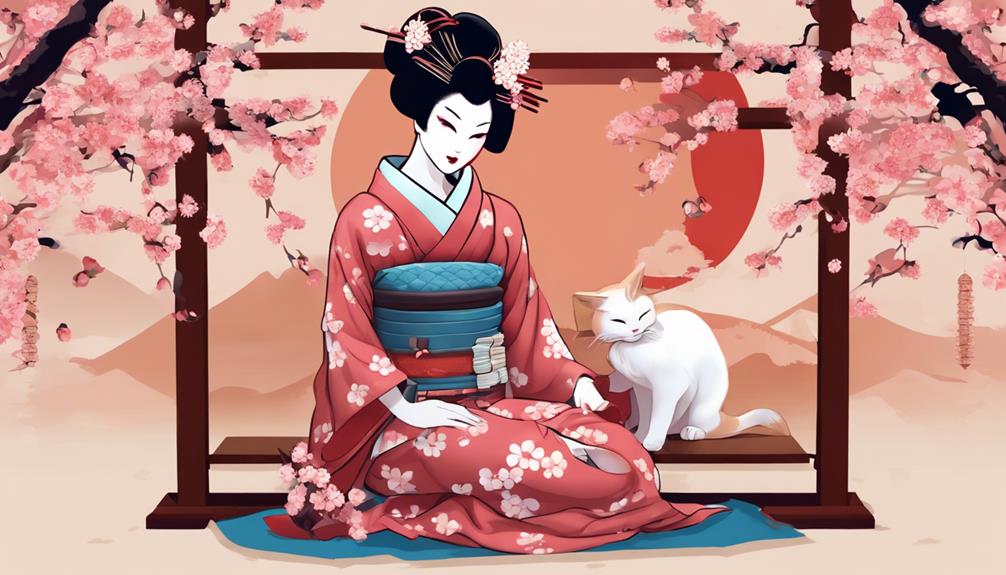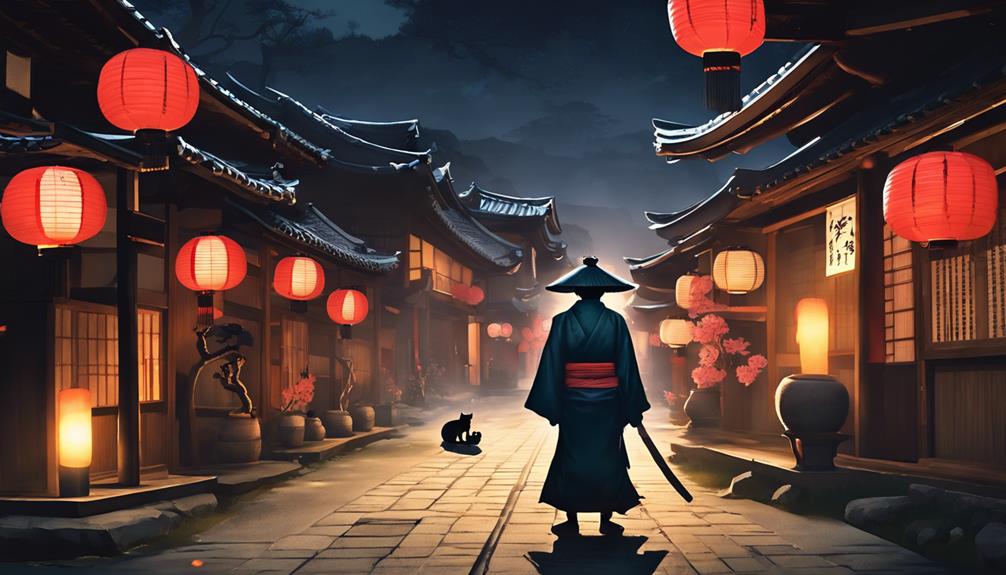Eight Fascinating Stories of Maneki-neko in Japanese Folklore
You may find it intriguing to explore the tales surrounding the enigmatic Maneki-neko in Japanese folklore. From its mysterious origins to encounters with samurais, emperors, and even geishas, the stories of these beckoning cats are as diverse as they are captivating.
Each narrative offers a unique glimpse into the cultural significance and symbolism behind this iconic talisman. Discover how these eight fascinating stories intertwine with history, tradition, and the supernatural, leaving you eager to uncover more about the enduring charm of the Maneki-neko.
The Origin Story of Maneki-Neko
Tracing back to ancient Japan, the origin story of Maneki-Neko reveals intriguing tales of luck and fortune. The waving paw of the Maneki-Neko, also known as the beckoning cat, is a symbol deeply rooted in Japanese tradition. This figurine holds a special place in the hearts of the Japanese people, believed to bring good luck and prosperity to its owners.
The Maneki-Neko's cultural significance stems from a legend that tells the story of a poor temple priest who was struggling to make ends meet. One stormy night, a cat beckoned him to come near the temple gates. Curious, the priest followed the cat's gesture and sought shelter under a tree. Moments later, lightning struck the very spot where he'd been standing. Grateful for the cat's warning, the temple priest found that the cat had brought him good fortune. To honor the cat's loyalty and protection, the priest had a statue made in its likeness, thus starting the tradition of the Maneki-Neko.
Through centuries, the Maneki-Neko has become a beloved symbol in Japanese folklore, adorning homes and businesses alike to attract prosperity and ward off evil spirits. Its waving paw continues to beckon good luck into the lives of those who embrace this charming piece of Japanese heritage.
Maneki-Neko and the Samurai
Maneki-Neko held a special significance for the samurai, symbolizing luck and protection in their endeavors. In addition to bringing good fortune, the Maneki-Neko also carried a deeper meaning for the samurai. The samurai, known for their honor and loyalty, viewed the Maneki-Neko as a symbol of their values and principles. The cat's beckoning paw represented the beckoning of opportunities and success, encouraging the samurai to seize the moment and make the most of their skills and abilities.
For the samurai, the Maneki-Neko was more than just a charm; it was a reflection of their cultural symbolism. The cat's gesture of raising its paw mirrored the samurai's readiness to take action and face challenges with courage and determination. The samurai believed that having a Maneki-Neko in their presence wouldn't only bring them luck but also remind them of the importance of staying true to their code of honor.
Maneki-Neko in the Temple
As the samurai sought solace and guidance in the presence of the Maneki-Neko, their journey often led them to the tranquil setting of the temple, where the cat's benevolent aura permeated the sacred space. Within the temple walls, the Maneki-Neko played a pivotal role in temple traditions, embodying spiritual significance that resonated deeply with those who entered.
Temple traditions surrounding the Maneki-Neko were steeped in reverence and belief. Visitors would often bring small statues or images of Maneki-Neko as offerings to the temple, seeking blessings for prosperity, good fortune, and protection. The cat's raised paw symbolized beckoning good luck and fortune into the lives of those who paid their respects.
The spiritual significance of the Maneki-Neko in the temple was profound. It was believed that the cat's presence could ward off evil spirits and bring about positive energy to all who crossed its path. Many worshippers would kneel before the Maneki-Neko, offering prayers and incense as a gesture of respect and devotion.
In the hushed ambiance of the temple, the Maneki-Neko stood as a guardian and guide, embodying the hopes and dreams of those who sought solace within its serene surroundings. Its watchful eyes and inviting paw beckoned visitors to embrace its message of good fortune and protection, making it a cherished symbol in temple lore.
Maneki-Neko and the Fisherman
Entranced by the shimmering waters, the fisherman's gaze was drawn to the glint of a Maneki-Neko perched on the shore. The cat figurine's paw was raised in a beckoning gesture, its expression welcoming and serene. As you approached, a sense of tranquility washed over you, and you couldn't help but wonder about the symbolism behind this iconic charm.
- The maneki neko symbolism is deeply rooted in Japanese culture, symbolizing good fortune, wealth, and prosperity. Its beckoning paw is believed to attract positive energy and bring luck to its owner.
- Cultural significance: In Japanese folklore, the Maneki-Neko is often associated with stories of generosity and kindness. It's said that those who heed its beckoning call will be blessed with success and happiness.
The fisherman's heart swelled with gratitude as he contemplated the significance of the Maneki-Neko. Its presence seemed to promise a bountiful catch and safe journeys ahead.
The humble figurine held a powerful message: amidst life's uncertainties, there's always hope and a guiding light. The fisherman felt a renewed sense of purpose, knowing that the Maneki-Neko was watching over him.
Maneki-Neko and the Geisha

The graceful geisha's eyes widened in awe as she noticed the beckoning paw of the cat figurine by the doorway, a symbol of potential prosperity and good fortune. In Japanese culture, the Maneki-Neko holds a special place with geishas, embodying deeper meanings beyond its charming appearance.
Geisha symbolism intertwines seamlessly with the essence of the Maneki-Neko. Geishas, known for their artistry, elegance, and grace, symbolize tradition and cultural heritage. Similarly, the Maneki-Neko, with its raised paw and welcoming gesture, represents luck and beckoning good fortune. When these two symbols converge, a rich tapestry of cultural significance unfolds.
For geishas, the presence of a Maneki-Neko can signify auspicious beginnings in their performances. The cat's beckoning paw mirrors the geishas' inviting demeanor, drawing in patrons and fostering a harmonious atmosphere. Moreover, the Maneki-Neko's role as a harbinger of prosperity aligns with the geishas' aspirations for success in their artistic pursuits.
In the world of geishas, where tradition meets artistry, the Maneki-Neko serves as a charming companion symbolizing luck and abundance. Its place by the doorway not only adds a touch of whimsy but also infuses the space with the promise of good fortune, creating an ambiance where geisha traditions thrive alongside the beckoning cat's cultural significance.
Maneki-Neko and the Emperor
The regal presence of the Emperor alongside the Maneki-Neko introduces a realm where traditional symbolism meets imperial authority. The Emperor's favor towards the Maneki-Neko holds deep cultural significance in Japanese folklore, symbolizing blessings, prosperity, and protection. Here, the beckoning cat transcends its humble origins, becoming intertwined with the highest echelons of power and prestige.
- Imperial Blessings: The Maneki-Neko's connection to the Emperor signifies divine favor and protection, elevating its status to one of great importance in Japanese culture.
- Symbol of Prosperity: The Emperor's admiration for the Maneki-Neko highlights its role as a harbinger of wealth and good fortune, believed to bring financial success to those who possess it.
- Guardian of Imperial Authority: Seen as a guardian of the Emperor's favor, the Maneki-Neko embodies loyalty and protection, ensuring the well-being of the imperial household.
- Cultural Reverence: The depiction of the Emperor with the Maneki-Neko reflects the deep-rooted respect and reverence for tradition within Japanese society, showcasing the cat's significance beyond mere superstition.
Maneki-Neko and the Ronin

Captivated by the Maneki-Neko's beckoning paw, a ronin found unexpected solace and guidance in its enigmatic gaze. As a ronin, a masterless samurai wandering the land in search of purpose, loyalty held immense significance. The Maneki-Neko, with its raised paw symbolizing welcome and good fortune, seemed to offer the loyalty and companionship the ronin longed for in his solitary journey.
In Japanese folklore, ronin were often depicted as individuals of honor and integrity, facing adversity with courage and resilience. The Maneki-Neko, believed to bring luck and prosperity to its owner, became a symbol of hope for the ronin, a beacon of light in times of darkness. Its presence served as a reminder of the ronin's own values of loyalty and perseverance, inspiring him to continue his quest with renewed determination.
The cultural significance of this encounter between the ronin and the Maneki-Neko lies in the parallel between their journeys. Both the ronin and the Maneki-Neko embody traits such as loyalty, resilience, and the pursuit of a meaningful path. Through this connection, the ronin found not only a source of comfort but also a reflection of his own unwavering spirit in the face of adversity. The tale of the ronin and the Maneki-Neko serves as a poignant reminder of the enduring power of loyalty and the unexpected sources of guidance that can illuminate our paths.
Modern Maneki-Neko Tales
Indulge in a collection of captivating modern tales featuring Maneki-Neko, showcasing their continued relevance and charm in contemporary settings.
- Modern interpretations: In today's society, Maneki-Neko has evolved beyond a mere symbol of luck. People now view these beckoning cats as a representation of prosperity, happiness, and good fortune in various aspects of life.
- Cultural significance: The Maneki-Neko has seamlessly integrated into modern Japanese culture, adorning shops, restaurants, and homes as a symbol of welcoming guests and attracting positive energy. Its popularity remains unwavering, symbolizing the blend of tradition and modernity in Japan.
- Contemporary variations: Artists and designers have reimagined the classic Maneki-Neko in innovative ways, creating contemporary versions that resonate with younger generations. These new interpretations breathe fresh life into the traditional talisman.
- Symbolism in art: Beyond its commercial use, the Maneki-Neko has become a muse for many artists. Its iconic raised paw and cheerful expression inspire various forms of artistic expression, from paintings to sculptures, enriching the art scene with its symbolic value and aesthetic appeal.
Frequently Asked Questions
How Did the Different Colors and Variations of Maneki-Neko Come to Be Associated With Specific Types of Blessings or Fortunes?
Different colors and variations of maneki-neko are linked to specific blessings through color symbolism. Evolution in art and cultural significance shaped these associations.
White maneki-neko symbolize purity and positive energy. Black ones are thought to ward off evil spirits. Gold signifies wealth and prosperity. Calico cats are believed to bring good fortune in business.
These color-based connections have deep roots in Japanese folklore and have become ingrained in the symbolism of maneki-neko.
Are There Any Superstitions or Taboos Surrounding the Placement or Use of Maneki-Neko in Japanese Culture?
When it comes to maneki-neko in Japanese culture, there are indeed some superstitions and taboos to be mindful of. Traditionally, the placement of these beckoning cats is crucial as it's believed to affect the type of fortune they bring.
For example, placing a maneki-neko near the entrance of your home or business is considered auspicious, while placing it in a disrespectful location may bring bad luck. Following these beliefs can help attract good fortune your way.
Have There Been Any Documented Cases of Maneki-Neko Bringing Bad Luck or Misfortune to Its Owners?
Have there been any documented cases of maneki-neko bringing bad luck or misfortune to its owners?
While the majority of stories and beliefs surrounding maneki-neko focus on their positive influence, there have been rare instances where some people claim to have experienced negative outcomes. However, these cases aren't widely documented or supported by historical origins or cultural significance.
Folklore interpretations and symbolic meanings generally emphasize the cat's role as a bringer of good luck and prosperity.
Are There Any Specific Rituals or Ceremonies Associated With the Creation or Blessing of Maneki-Neko Statues?
When crafting Maneki-neko statues, artisans often perform creation rituals to imbue them with positive energy. Blessing ceremonies are also common, where prayers are said to invite good fortune and luck into the statue. These rituals and ceremonies are believed to enhance the effectiveness of the Maneki-neko in bringing prosperity to its owners.
What Role Does Maneki-Neko Play in Modern Japanese Society and Popular Culture Outside of Traditional Folklore and Superstitions?
In modern Japanese society and popular culture, the maneki-neko plays a significant role. Its global influence has led to widespread recognition as a symbol of good luck and prosperity.
Modern adaptations of the maneki-neko can be seen in various forms, from merchandise to digital media. Its presence in everyday life showcases how this traditional charm has seamlessly integrated into contemporary culture, becoming a beloved icon that transcends its origins in folklore and superstitions.
Conclusion
So, there you have it – eight fascinating stories of maneki-neko in Japanese folklore. From its humble origins to its interactions with samurais, emperors, and even geishas, the maneki-neko has woven its way into the fabric of Japanese culture.
Whether you believe in its powers or simply appreciate its cute appearance, the maneki-neko continues to be a beloved symbol of good luck and prosperity in Japan and beyond.
